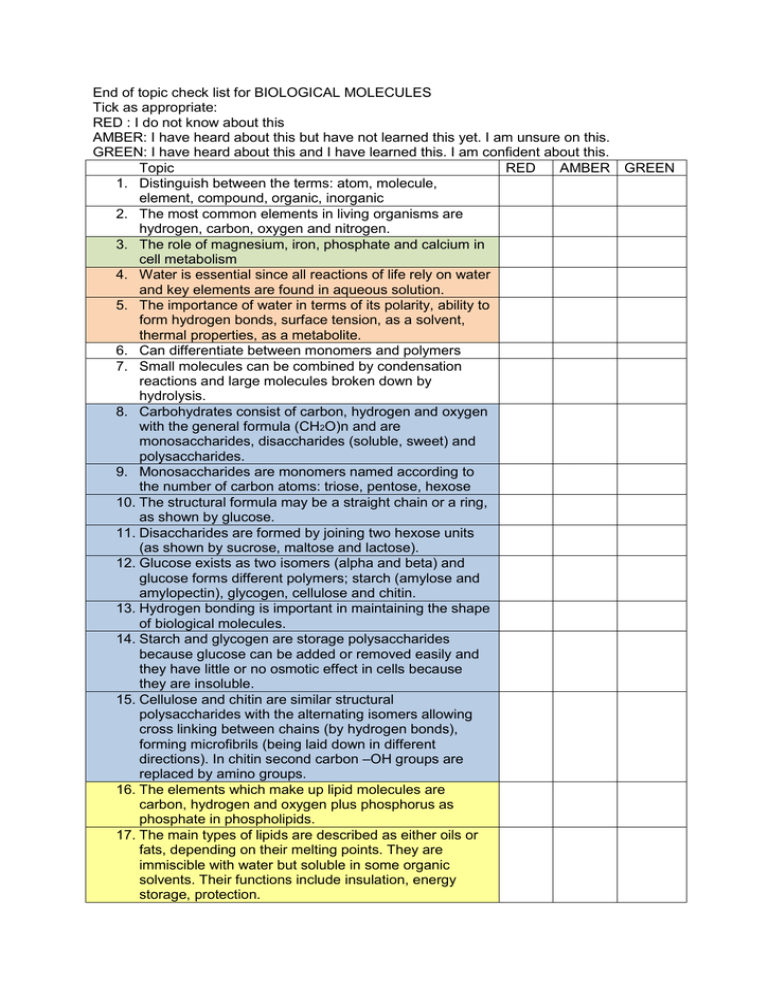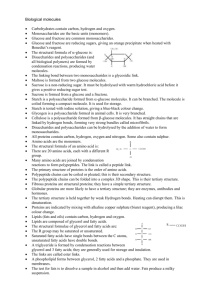Traffic Lights
advertisement

End of topic check list for BIOLOGICAL MOLECULES Tick as appropriate: RED : I do not know about this AMBER: I have heard about this but have not learned this yet. I am unsure on this. GREEN: I have heard about this and I have learned this. I am confident about this. Topic RED AMBER GREEN 1. Distinguish between the terms: atom, molecule, element, compound, organic, inorganic 2. The most common elements in living organisms are hydrogen, carbon, oxygen and nitrogen. 3. The role of magnesium, iron, phosphate and calcium in cell metabolism 4. Water is essential since all reactions of life rely on water and key elements are found in aqueous solution. 5. The importance of water in terms of its polarity, ability to form hydrogen bonds, surface tension, as a solvent, thermal properties, as a metabolite. 6. Can differentiate between monomers and polymers 7. Small molecules can be combined by condensation reactions and large molecules broken down by hydrolysis. 8. Carbohydrates consist of carbon, hydrogen and oxygen with the general formula (CH2O)n and are monosaccharides, disaccharides (soluble, sweet) and polysaccharides. 9. Monosaccharides are monomers named according to the number of carbon atoms: triose, pentose, hexose 10. The structural formula may be a straight chain or a ring, as shown by glucose. 11. Disaccharides are formed by joining two hexose units (as shown by sucrose, maltose and lactose). 12. Glucose exists as two isomers (alpha and beta) and glucose forms different polymers; starch (amylose and amylopectin), glycogen, cellulose and chitin. 13. Hydrogen bonding is important in maintaining the shape of biological molecules. 14. Starch and glycogen are storage polysaccharides because glucose can be added or removed easily and they have little or no osmotic effect in cells because they are insoluble. 15. Cellulose and chitin are similar structural polysaccharides with the alternating isomers allowing cross linking between chains (by hydrogen bonds), forming microfibrils (being laid down in different directions). In chitin second carbon –OH groups are replaced by amino groups. 16. The elements which make up lipid molecules are carbon, hydrogen and oxygen plus phosphorus as phosphate in phospholipids. 17. The main types of lipids are described as either oils or fats, depending on their melting points. They are immiscible with water but soluble in some organic solvents. Their functions include insulation, energy storage, protection. 18. Understand the structure of triglycerides and the structural formula for glycerol and general formula for a fatty acid. Unsaturated fatty acids contain double bonds. 19. Lipids are used, rather than carbohydrates, as an energy store in seeds and animals because of a high yield of energy per gram. 20. The products of lipid hydrolysis are fatty acids and glycerol. 21. The components of phospholipids are glycerol, fatty acids and a phosphate group. 22. Glycerol is hydrophilic and fatty acids hydrophobic 23. A high intake of fat, notably saturated fats, is a contributory factor in heart disease. 24. Able to draw the general formula for amino acids and recognise amino (basic) and carboxylic (acidic) groups. 25. Proteins are polymers of amino acids of which there are twenty types which differ by the R group. Can identify amino acid structure, given a structural formula and a suitable table showing -R groups. 26. Polymerisation occurs by condensation, to form peptide bonds giving rise to dipeptides and polypeptides. Can complete a diagram showing condensation, given the structural formula of an amino acid. 27. Proteins show a primary, secondary, tertiary and quaternary structure. 28. Primary is the type, number and sequence of amino acids linked by peptide bonds only. 29. The most common secondary structure is an alpha helix formed by hydrogen bonding between the peptide bonds in the polypeptide chain. 30. The tertiary structure is the folding of the alpha helix, as shown by globular proteins, to form very specific threedimensional shapes. 31. Projecting from the helix are -R groups which may interact to form bonds which help to maintain the tertiary structure’s three dimensional shape. 32. Able to identify disulphide, ionic, hydrogen and hydrophobic bonds between -R groups. 33. The quaternary structure is where two or more polypeptide chains in tertiary form combine to form complexes joined by bonds similar to those in tertiary structure. Only some proteins, such as haemoglobin, exhibit quaternary structure 34. Proteins can be classified according to function which is determined by structure: globular proteins function as enzymes, antibodies and hormones; fibrous proteins such as keratin and collagen have alpha helices linked into strands.





